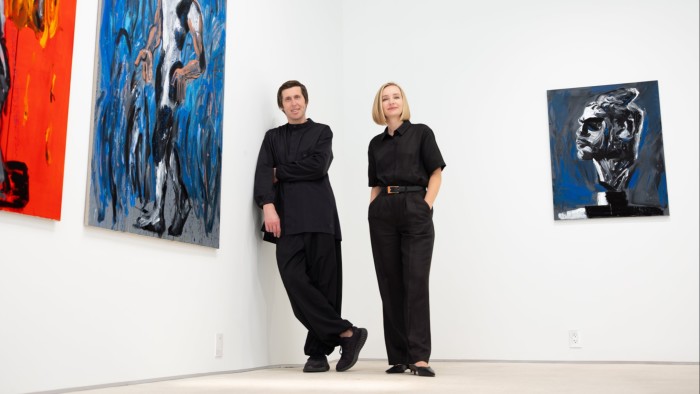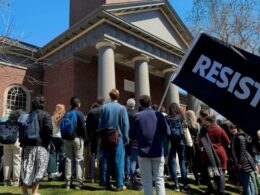Unlock the Editor’s Digest for free
Roula Khalaf, Editor of the FT, selects her favourite stories in this weekly newsletter.
When Russia launched its full-scale invasion of Ukraine in 2022, Voloshyn gallery in Kyiv became a refuge for its artists and employees. The space had served as a bomb shelter during the second world war — and so it did again. The artist Nikita Kadan lived in the gallery for more than two months, during which he became “interested in how we can look at Ukrainian art history through the lens of this war”. Sifting through artworks in Voloshyn’s storage, he curated an exhibition titled Tryvoha (Anxiety), with historical works by 20th-century Ukrainian artists “which had the shadow of catastrophe on them”, arranged around his mattress.
“Many things became really obvious about Ukrainian 20th-century art,” Kadan observes. “This art was made during revolutions and wars, almost each of our important 20th-century artists had an experience of surviving a big historical catastrophe.” These include the October revolution of 1917 and the war that followed, the Holodomor famine, Stalin’s purges, the second world war, and the collapse of the Soviet Union — meaning that “almost no one worked in totally peaceful times”.
Now Kadan makes art about the effects of war, from metal sculptures which reference the bombing of a playground where he and his daughter would play, to a sound piece that evokes the relentless scream of air raid sirens. “It’s not so different for my generation,” Kadan says. “It’s like a mutation. We who live in war are changed.”
When Ukraine was attacked in 2022, Max and Julia Voloshyn — who founded the eponymous gallery in 2016 — were left stranded in the US, having stayed on after a run of art fairs. Just weeks before Russian forces crossed into Ukraine, the Voloshyns had opened a pop-up show in Miami, The Memory on Her Face, which featured older works about their country’s conflict with Russia — including Oleksiy Sai’s Bombed series, which look like aerial views of craters, begun during Russia’s 2014 invasion of Crimea and the Donbas.
The Voloshyns found another permanent gallery space in Miami’s Allapattah neighbourhood, already home to a small cohort of galleries and within walking distance of the Rubell Museum. In addition to providing a US platform for contemporary Ukrainian artists, the Voloshyns are interested in building a dialogue between eastern Europe and the Americas. In September they will open an exhibition of 20th-century and contemporary Ukrainian artists curated by Kadan while simultaneously in Kyiv unveiling an exhibition of artists from the US curated by Los Angeles-based artist Harold Mendez.

They hope to take the Miami show to Latin America early next year. Julia Voloshyn explains: “We have some similarities and histories of colonial pasts.” Max adds that some Latin American countries are also “under Russian influence — and we’d like to change this as much as we can”.
Many of the artists that Voloshyn represents contend with the realities of a country at war. “I am constantly thinking how some artists in peaceful political climates can play freely,” says Dallas-based Ukrainian curator Lilia Kudelia, who has curated several recent exhibitions for the gallery. “At the same time, in other parts of the world artists are grappling with what it feels to be alive in this brutal new century.”
“People want to live as normal a life as possible,” Max Voloshyn says. When the couple decided to reopen the Kyiv gallery in April 2023, they did so not to make money, he says, but rather “to support the local community and people in Ukraine by continuing our programme”.

“All this raising money through selling art, it’s not about charity,” Kadan adds. “No, it’s very practical self-defence. We don’t just do it for others — we do it for ourselves.”
“It sounds crazy,” Max admits, “but in the country during war, we can still sell art. Ukrainians are so great and resilient, we believe in our culture and we believe we need to support artists in Ukraine and galleries that still operate.”

When they started attending fairs in 2016, he says, “it was very difficult. Because almost no Ukrainian galleries participated in fairs anywhere, no one knew any galleries from Ukraine. So people didn’t know if ours was a good gallery or not.”
This month in New York, Voloshyn will be the first gallery from Ukraine to participate in Frieze, where Kadan will have a solo show, Kyiv Siren, in the fair’s Focus section. At the Independent art fair, they will present Albanian artist Abi Shehu alongside Ukrainian filmmakers Yarema Malashchuk and Roman Khimei, who have documented the experiences of Ukrainian children who were returned home years after being deported to Russia. Though Max Voloshyn acknowledges that not knowing how collectors, institutions and the press will respond “is always a risk”, he thinks “now it’ll be a little bit easier for galleries from Ukraine to apply to participate”.
“We want to speak through art and bring what is happening in Ukraine to a global discourse,” Julia Voloshyn adds. “And we think it’s very important for artists, for us as a gallery, and for Ukraine as a country.”

Find out about our latest stories first — follow FT Weekend on Instagram and X, and sign up to receive the FT Weekend newsletter every Saturday morning









